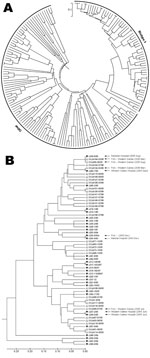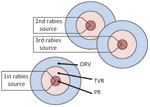Volume 15, Number 8—August 2009
Dispatch
Epidemiologic Study of Vibrio vulnificus Infections by Using Variable Number Tandem Repeats
Abstract
A 3-year environmental and clinical Vibrio vulnificus survey using simple-sequence repeats typing shows that V. vulnificus biotype 3 constitutes ≈21% of the bacterium population in tested aquaculture ponds as opposed to ≈86% of clinical cases. Simple-sequence repeats proved to be a useful epidemiologic tool, providing information on the environmental source of the pathogen.
Vibrio vulnificus is a highly invasive human pathogen and presents a food safety issue worldwide. Human infections caused by V. vulnificus are primarily caused by contaminated seafood consumption or contaminated skin wounds, which can lead to septicemia, wound infections, and high hospitalization and fatality rates (1,2). V. vulnificus strains are biochemically divided into 3 biotypes (BTs). BT3, found in Israel, is associated with infections caused by contaminated fish (3). Until now, only 3 BT3 isolates had been isolated from the environment in direct contrast with their large clinical numbers (3,4).
BT3 is a clonal group, which various molecular methods have failed to differentiate among its strains, (4,5) with the exceptions of rep-PCR (6), simple-sequence repeats (SSR) (7), and recently pulsed-field gel electrophoresis (PFGE) (8). SSR analysis of V. vulnificus was highly discriminative among BT3 strains (7). These SSR markers have been used for typing and for epidemiologic studies in many bacterial species (9,10). We present results from a 3-year monitoring program of clinical and environmental V. vulnificus using SSR as an epidemiologic genotyping tool.
A total of 414 V. vulnificus isolates were studied, including a reference panel of 32 strains previously studied (7). A total of 360 environmental V. vulnificus isolates were successfully retrieved from September 2004 through October 2006 from artificial fish ponds and stores in the western Galilee region of Israel (from 21 samplings), and 22 clinical isolates were retrieved from nearby hospitals during matching years (Tables 1, 2). Fish samples were collected and gills and fins/scales were pooled from ≈10 Tilapia spp. (300–400 g). Each sample was incubated in 0.5 L modified alkaline peptone water with 4% NaCl, pH 6.9, at 37oC for 16 to 18 h. Samples were diluted in saline and streaked on thiosulfate-citrate-bile-salts-sucrose (TCBS) agar. Suspected colonies were further grown on chromogenic agar (CHROMagar Microbiology, Paris, France), and validated by amplification of V. vulnificus–specific gene vvh (7). All V. vulnificus colonies were green on TCBS agar. Notably, not all bacterial isolates showed the expected turquoise-colonies on CHROMagar but rather pale white colonies. The latter colonies were further identified as BT3. All other isolates, which were BT1, showed the expected turquoise-colony phenotype. No BT2 isolates were found. However, 6 previously studied isolates (7) showed the expected turquoise-colony.
SSRs were used to genetically characterize 254 clinical and environmental V. vulnificus isolates (Table 1), including 32 previously studied isolates (7). DNA extraction, PCR and primers, SSR sizing, and statistical analysis were conducted as previously described (7). Capillary electrophoresis was performed by using a 3130 Genetic Analyzer and analyzed with GeneMapper-v4.0 (Applied-Biosystems Inc., Foster City, CA, USA). Two to 34 alleles were detected at the 12 SSR loci among the isolates. Environmental isolates were selected from 21 samples with an average 8.5 isolates per enrichment. We removed 71 isolates that had identical SSR genotypes and originated from the same enrichment from the analysis because they were probably clones. Thus, 183 isolates were discriminated to 170 SSR types. SSR variation data was used to calculate genetic relationships among isolates. A genetic distance matrix was generated followed by cluster analysis (7). The resulting dendrogram (Figure 1) showed clear separation between BT3 isolates and the others (average genetic distance of 0.825 ± 0.101). Genetic distances among BT3 isolates were rather low (average 0.369 ± 0.174) relative to high genetic distances (average 0.804 ± 0.149) found among isolates of the other biotypes, in accordance with our previous analysis of 32 isolates (7). The new studied isolates showed a variety of SSR genotypes and were spread throughout the dendrogram (Figure 1). Further analysis using eBURST (12) showed similar grouping results (data not shown) (7).
Differentiation of SSR alleles results at locus VV0401 into environmental types (E-types, >12 repeats), and clinical types (C-types, <10 repeats) was tested (13). Of the clinical isolates, 44 isolates (98%) exhibited the expected C-type allele/repeat but only 69 isolates (33%) of the environmental isolates showed the E-type allele/repeat, rejecting the null hypothesis (p<0.0001), using Pearson χ2 test. Notably, 97% of 110 BT3 isolates (clinical/environmental) showed the C-type allele/repeat, in contrast to BT1 isolates (72 isolates, 2%). If, C-type allele/repeat at VV0401 is an indication of potential pathogenicity of V. vulnificus strains, then our results further support the high virulence of BT3. However, additional studies are needed to confirm the relationship of this locus to pathogenicity.
Three clinical BT3 isolates exhibited identical SSR genotypes and 2 clinical BT3 isolates had a genotype related to 5 environmental isolates sampled on related dates from nearby regional areas (Figure 1, panel B). One clinical BT3 isolate v239 (August 2005) showed SSR genotypes identical to the environmental isolate VVyb95 obtained in the same month (August 2005) and to VVyb194 (obtained in March 2006). A second BT3 clinical isolate v240 (October 2005) and the fish-pond isolate VVyb132 (March 2006) had identical SSR genotypes. Moreover, these 2 results suggest survival of V. vulnificus strains through the winter season, either in a viable nonculturable state (14) or as viable cells in sediment that can serve as a shelter for some subpopulations (15). The latter scenario is more probable in artificial fish ponds because water circulation is high throughout the growth period and pond sediment remains untouched. A third clinical isolate was analyzed earlier and showed an epidemiologic connection: v254 isolate was obtained from an injured woman (injured by a fish) in December 2003. Analysis of microbial flora on the fish (found in the woman’s freezer) identified a V. vulnificus BT3 isolate, v232. These 2 isolates showed identical SSR genotypes, confirming the fish as the origin of infection (Figure 1, panel B). Additionally, clinical BT1 isolate v252 (August 2004), showed similar SSR genotypes, 1 repeat difference in 1 locus, to environmental isolate VVyb50 (October 2004).
To strengthen our typing results, we compared the epidemiologic SSR results to those of PFGE in 12 representative BT3 isolates. PFGE was performed and analyzed as described previously (8). Results for PFGE were generally similar to results for SSR (Figure 2). PFGE patterns were similar (>85%) between isolates. Identical PFGE patterns and SSR genotypes were seen in isolates v239 (clinical) and VVyb95, VVyb194 (environmental), as were isolates v232 (fish) and v254 (clinical). Identical PFGE patterns and single-locus variants in SSR genotypes were seen in clinical isolate v237 and the environmental isolates VVyb89 and VVyb1. Notably, VVyb1, which was isolated a year earlier, differentiated from VVyb89 by another single repeat in an additional single locus, confirming higher resolution of SSR method. Finally, identical SSR genotypes and PFGE patterns that differed by 1 band were seen in v240 and VVyb132.
The developed isolation and enrichment procedures obtained large numbers of BT3 and BT1 from the environment. Results showed that although BT3 makes up only ≈21% of the V. vulnificus isolates from fish, BT3 accounts for ≈86% of the clinical cases and thus could imply high pathogenicity for this group (4). Genetic analysis of this large survey confirms the distinctness (clonality) (5) of BT3 and the high resolution power of the SSR (7).
SSR genotyping of V. vulnificus was used to determine the genetic relatedness between clinical and environmental isolates and identify the source of contamination. SSR can serve as an epidemiologic tool to indicate the infection source of pathogens such as V. vulnificus, and can potentially provide knowledge for preventive steps in terms of public health.
Dr Broza was a PhD student in the laboratory of Applied Genomics at the Faculty of Biotechnology and Food Engineering, Technion-Israel Institute of Technology, at the time of this study. This work was part of his dissertation on the human pathogen V. vulnificus. His current research is studying nanomaterial-based sensors for detection of disease biomarkers through breath samples.
Acknowledgments
We thank Zinaida Korenman for technical assistance.
This research was supported by The Environment and Health Fund, RGA0804; the Institute for Future Security Study, Technion; the Grand Water Research Institute, Technion; the Israeli Water Commission; and NATO, Project CBD.MD.SFP 981456.
References
- Farmer JJ. Vibrio. In: Patrick RM, Ellen JB, James HJ, Michael AP, Robert HY, editors. Manual of clinical microbiology. Washington: American Society for Microbiology Press; 2003. p. 706–16.
- Oliver JD. Vibrio vulnificus. In: Doyle MP, editor. Food borne bacterial pathogens. New York: Marcel Dekker Inc.; 1989. p. 569–600.
- Bisharat N, Agmon V, Finkelstein R, Raz R, Ben Dror G, Lerner L, Clinical, epidemiological, and microbiological features of Vibrio vulnificus biogroup 3 causing outbreaks of wound infection and bacteraemia in Israel. Lancet. 1999;354:1421–4. DOIPubMedGoogle Scholar
- Bisharat N, Cohen DI, Harding RM, Falush D, Crook DW, Peto T, Hybrid Vibrio vulnificus. Emerg Infect Dis. 2005;11:30–5.PubMedGoogle Scholar
- Bisharat N, Amaro C, Fouz B, Llorens A, Cohen DI. Serological and molecular characteristics of Vibrio vulnificus biotype 3: evidence for high clonality. Microbiology. 2007;153:847–56. DOIPubMedGoogle Scholar
- Chatzidaki-Livanis M, Hubbard MA, Gordon K, Harwood VJ, Wright AC. Genetic distinctions among clinical and environmental strains of Vibrio vulnificus. Appl Environ Microbiol. 2006;72:6136–41. DOIPubMedGoogle Scholar
- Broza YY, Danin-Poleg Y, Lerner L, Broza M, Kashi Y. Vibrio vulnificus typing based on simple sequence repeats: insights into the biotype 3 group. J Clin Microbiol. 2007;45:2951–9. DOIPubMedGoogle Scholar
- Zaidenstein R, Sadik C, Lerner L, Valinsky L, Kopelowitz J, Yishai R, Clinical characteristics and molecular subtyping of Vibrio vulnificus illnesses, Israel. Emerg Infect Dis. 2008;14:1875–82. DOIPubMedGoogle Scholar
- Danin-Poleg Y, Cohen LA, Gancz H, Broza YY, Goldshmidt H, Malul E, Vibrio cholerae strain typing and phylogeny study based on simple sequence repeats. J Clin Microbiol. 2007;45:736–46. DOIPubMedGoogle Scholar
- Torpdahl M, Sorensen G, Lindstedt BA, Nielsen EM. Tandem repeat analysis for surveillance of human Salmonella typhimurium infections. Emerg Infect Dis. 2007;13:388–95. DOIPubMedGoogle Scholar
- Tamura K, Dudley J, Nei M, Kumar S. MEGA4: Molecular Evolutionary Genetics Analysis (MEGA) software version 4.0. Mol Biol Evol. 2007;24:1596–9. DOIPubMedGoogle Scholar
- Feil EJ, Li BC, Aanensen DM, Hanage WP, Spratt BG. eBURST: inferring patterns of evolutionary descent among clusters of related bacterial genotypes from multilocus sequence typing data. J Bacteriol. 2004;186:1518–30. DOIPubMedGoogle Scholar
- Rosche TM, Yano Y, Oliver JD. A rapid and simple PCR analysis indicates there are two subgroups of Vibrio vulnificus which correlate with clinical or environmental isolation. Microbiol Immunol. 2005;49:381–9.PubMedGoogle Scholar
- Oliver JD. The viable but nonculturable state in bacteria. J Microbiol. 2005;43:93–100.PubMedGoogle Scholar
- Randa MA, Polz MF, Lim E. Effects of temperature and salinity on Vibrio vulnificus population dynamics as assessed by quantitative PCR. Appl Environ Microbiol. 2004;70:5469–76. DOIPubMedGoogle Scholar
Figures
Tables
Cite This ArticleTable of Contents – Volume 15, Number 8—August 2009
| EID Search Options |
|---|
|
|
|
|
|
|


Please use the form below to submit correspondence to the authors or contact them at the following address:
Yechezkel Kashi, Department of Biotechnology and Food Engineering, The Technion, Haifa 32000, Israel
Top